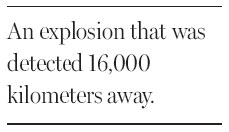After asteroid, a sigh of relief on Earth
Updated: 2013-04-07 07:44
By Henry Fountain(The New York Times)
|
|||||||
|
Since an asteroid exploded over Chelyabinsk, Russia, in February, scientists around the world have been analyzing data from the event, hoping to better understand it. Jorge Zuluaga and Ignacio Ferrin via arxiu (top row sides); NASA (top Center); Images from stefan geens and ogle earth via Google earth and Youtube (bottom row) |

Using an eclectic mix of crowd-sourced video, information from Google Earth and data from nuclear test-ban sensors, scientists have gotten a much more accurate picture of the small asteroid that exploded near the Russian city of Chelyabinsk in February.
But what is most clear is that while Chelyabinsk did not exactly dodge a bullet, the city was fortunate to be only grazed by it. "The people of Chelyabinsk were very lucky," Dr. Edward Lu, a former astronaut who now leads the B612 Foundation, a private initiative to detect similar asteroids, said in Washington in March.
The Russian meteor - which was about 18 meters in diameter and came in undetected at roughly 67,000 kilometers an hour - was almost 24 kilometers high when it blew apart. There were no deaths, and most of the 1,500 injuries were from glass as windows shattered when a shock wave hit the city 88 seconds later.
"If it had detonated closer to the ground, it would have been worse," said Dr. Margaret Campbell-Brown, a member of a team of researchers at the University of Western Ontario.
The Canadian team has calculated that the energy released in the Chelyabinsk explosion was the equivalent of about 440 kilotons of TNT, or about 30 times the power of the Hiroshima nuclear bomb.
That calculation was made with the help of data from a network of acoustic sensors set up to monitor compliance with the treaty to ban nuclear weapons testing. There are about 45 of the sensors worldwide.
Thomas Mutzelburg, a spokesman for the Preparatory Commission for the Comprehensive Nuclear-Test-Ban Treaty Organization, which is based in Vienna, said the explosion was detected by more than 20 of the sensors, including one in Antarctica nearly 16,000 kilometers from Chelyabinsk.
With knowledge of the energy and information about how fast the meteor was traveling, researchers were able to calculate the mass of the meteor, about 11,000 metric tons. "It's all about the kinetic energy of that body," which is related to its mass and velocity, said Richard P. Binzel, a planetary scientist at the Massachusetts Institute of Technology. "All that kinetic energy has to be released."
The Canadian researchers have used video images of the meteor's east-to-west trail above Chelyabinsk to help calculate its trajectory and orbit. Since the explosion occurred in daylight, Dr. Campbell-Brown said they asked a colleague there to take night photographs from the same locations. By superimposing the images of the meteor's path over the night images containing stars, the researchers should be able to plot the path even more accurately.
For now, though, they and other teams, including one from the University of Antioquia in Medellin, Colombia, have established that the meteor originated in the inner part of the asteroid belt, in a regular, harmless orbit around the Sun between Mars and Jupiter. It then circled the Sun every 18 months in a highly eccentric orbit - more than two and a half times the Earth-Sun distance at its farthest - before it smacked into Earth.
Dr. Jorge Zuluaga, a member of the Colombian group, said he was inspired by work done soon after the event by Stefan Geens, a blogger in Stockholm. Mr. Geens used several videos to triangulate the path. The video does not show the explosion directly, but rather the shadows of lampposts, which moved like the shadow on a sundial as the fireball crossed the sky.
Dr. Zuluaga thinks that eventually it will be possible to reconstruct the rock's orbit so precisely that researchers may be able to detect it retroactively, by poring over images from sky-surveying telescopes taken the last time it flew near the Earth. "Then we can assign it a name," he said.
The videos that were posted online contributed to a surge in interest in projects to detect asteroids. Dr. Lu said his foundation had seen an increase in donations since the explosion.
"It made it more real to folks," he said. "There's nothing like a hundred YouTube videos to do that."
The New York Times
(China Daily 04/07/2013 page11)
